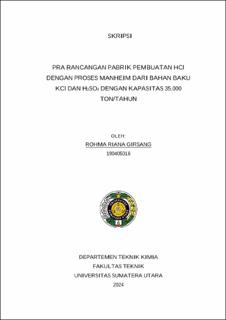Pra Rancangan Pabrik Pembuatan HCl dengan Proses Manheim dari Bahan Baku KCl dan H2So4 dengan Kapasitas 35.000 Ton/Tahun
Pre-Design of an HCl Manufacturing Plant using the Manheim Process from KCl and H2So4 Raw Materials with a Capacity of 35,000 Tons/Year

Date
2024Author
Girsang, Rohma Riana
Advisor(s)
Sarah, Maya
Bani, Okta
Metadata
Show full item recordAbstract
Chloride acid (HCl) is produced using the Mannheim Furnace process. This process was chosen because it was based on process, technology, and economic considerations. Chloride acid Industry is built with a capacity of 35,000 tons per year. Based on several factors, the rencana factory will be located in Cemarajaya, Karawang, Jawa Barat, with a total land area of 20,000 m2. The factory operates 24 hours per day, 310 working days per year, and employs 186 people.
The Mannheim furnace process begins with the addition of raw materials such as kalium kloride (garam) and asam sulfat. The furnace produces kloridized gas. The waiting process is then carried out on a silica tower. The gas is then routed via a coke tower to remove the sulfuric acid found in the gas. The chloride gas is then captured by an absorber, resulting in a chloride concentration of 45.2%. Larutan asam klorida 45,2% dimasukkan di tangki pengencer. In the tangki pengencer larutan asam klorida 45,2% diencerkan menjadi larutan asam klorida 37% dengan penambahan air proses utilitas. The final product is 37% klorida that is then applied to the skin.
The required utility is air flow of approximately 11,60 m3/jam. A total of 319.27 kWh was generated by the National Listrik Company (PLN) and a generator set. The generator requires 48 pounds of fuel per jam, whereas the furnace requires 344,499749 liters per jam.
Based on economic evaluations, the cost of producing klorida is still Rp 383.794.659.789, with manufacturing costs of Rp 131.934.000.412. The annual production cost is Rp 350.903.000.000, with a profit margin of Rp 65.416.567.676 and Rp55.604.082.524. Profitability was measured by the Rate of Investment (ROI) before and after pajak berturut-turut at 14% and 12%, the Pay of Time (POT) before and after pajak berturut-turut at 3 and 4 years, and the Break Event Point (BEP) at 45.79%.
Collections
- Undergraduate Theses [1239]
